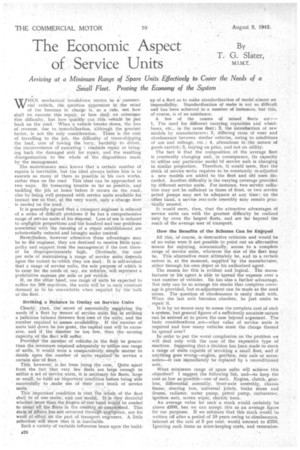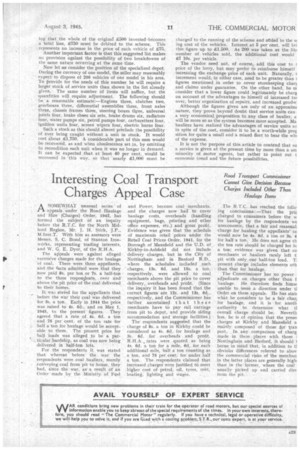The Economic Aspect of Service Units
Page 22

Page 25

If you've noticed an error in this article please click here to report it so we can fix it.
Arriving at a Minimum Range of Spare Units Effectively to Cover the Needs of a Stha11 Fleet. Proving the Economy of the System
By T. G. Slater,
M.1.M.T.
WHEN mechanical breakdown occurs to a .commercial vehicle, the question upperniost in the mind of the foreman in charge is, as a rule, hat how shall we execute this repair, or hew shall we ceitreolne this difficulty, but how quicklycan this vehicle tee put back on the road. When 'a vehicle breaks down, the loss of revenue, due to inemolailimation. although the greatest factor, .is not the only consideration. There is the cost of travelling to the job, the diffichlty of trans-shippinge the load, cost of towing the lorry, hardship to drivet, the inconvenience of executing !; roadside repair or bringing back the damaged unit for repair, and the resulting disorganization to the whole of the dispositions made by the management.
The maintenance man knows that a certain number of repairs is inevitable, but the ideal always before him is to execute as many of them as Possible in his own works, rather than on the road This ideal -can be approached in two ways. By foreseeing trouble so far as possible, and tackling the job at hoMe before it occurs On the road, also by being well prepared with service unite available for instant Use so that, at the yery worst, only a:-change Over
is needed on the road. ". " • '
It is generally agreed that a transport' erigtheee is relieved of a series of diffieult problems if he has a -comprehensive range of service units at his disposal, Loss of uSe is reduced to negligible proportions and the hundred and one probletns associated" with the ruenieg of a repair establishment are substantially reduced and brought under control: Nevertheless, however attractive these advantages may be to the engineer, they are destined to receive little sympathy and support from the management if the cost thereof bedisproportionately high. Obviously, the cost per mile of maintaining a range of Service units depends upon the extent to:which they are Used.' It is self-evident that a range of service units, the sole purpoSe of whiCh is to cater for the needs of, 'say, six vehicles, will repreSent a
prohibitiVe expense per mile or per vehicle, •
If, on the other hand, one range of units be eXpected to suffice for 500 machines, the units Will be in such constant demand is to be unavailable when required by thebulk of the fleet.
Striking a Balance in Outlay on Service Units Clearly, then, .the" secret of successfully supplying thc needs "of a fleet by means of service units lies in striking a judicious balance between first cost of the units', and the number required to assure availability. If the number of units laid down be too great, the capital cost Will be excessive, and if the number he too low, then the earning
capacity of the fleet suffer.
'
Providedthe number of vehicles,in the fleelt be greater than the 'minimum required adequately to 'utilize one range of units, it would Seem a comparatively sireple matter to decide Open the number of unitsrequired" to service a certain size-of fleet.
This, however, is far from being the ease, Quite apart from the fact that very few fleets are large enough to utilize a set of 'service units, it is necessary for fleets. large or small; to fulfil an important condition before being able successfully to ..make -use of their own stock of service units".
Thiseimporeant condition is that the whole of the fleet shall he of one make, and one model. It is very doubtful whether more than the fingers of one hand would be needed to count all the fleets in the eduntry. so coest,ittited. This state, oi 'affairs has not occurred through negligence, nor for want of effort oh the part of transport engineers. A little xefleCtion will show that it is inevitable.
Such a variety of variable influences bears upon the build up of a fleet as to make standardization of model almost an impossibility. Standardization of make ie not so difficult awl hasieeett achieved in a number of instances, but this, .of course, is of no assistance.
A 'few of the causes of mixed fleets are :— 1, The need for different carrying capacities and wheel
bases, etc., in the same fleet; 2, the introduction of new models by manufacturers; 3, differing rates of wear and obsolescence between similar vehicles, owing to conditions of use and mileage, etc. ; 4, alterations in the nature of goods carried; 5, buying on price, and not on utility.
The fact is that the composition of the average fleet is constantly changing and, in consequence, its capacity to utilize any particular model 'of service unit is changing in similar proportion. Therefore, it would seem, that the stock of service emits requires to be constantly re-adjusted a new models are added to the fleet and old ones dis carded. Another difficulty is the varying coverage provided by different service units. For instance, two service radia
tors may not be, sufficient in times of frost, or two service petrol pumps may not be adequate at any time; on the other hand, a servioe rear-axle assembly may remain prac
tically unused. , It 'would seem, then, that the attractive advantages of service units can with the greatest difficulty be realized Only by even the largest fleets, and are far beyond the reach of the average User of transport.
How the Benefits of the Scheme Can be Enjoyed All this, of course, is destructive criticism and would be of no value were it not possible to point out an alternative means for enjoying, economically, aocess to a complete range of service units, whatever the size of the fleet may be. This alternative must ultimately I:4e, and to a, certain extent is, at the moment, supplied' by the manufacturer, either through his own depot or his authorized agent.
The reason for this is evident and logical. The manufacturer or his agent is able to spread the expense over a vast number of vehicles. He has also a further advantage.
• Not only can he so arrange his stocks that complete coverage is providedebut re-adjustment can be made as the need arises. The question of obsolescence is easily dealt with. When the last unit becomes obsolete, he just omits to repair it.
It is by no means easy to assess the complete cost of such a system, but general figures of a sufficiently accurate-nature can be arrived at to prove the case beyond argument. The basic considerations .are—what value of service units is required and how many vehicles must -the charge thereof be spread over?
In order to put the worst complexion on the problem we will deal only with the case of the expensive type of machine. Supposing that a decision has been made to stock a range of units capable of servicing a small fleet, and if anything goes wrong—engine, gearbex, reataxle or accessories—it can immediately be replaced by a reconditioned unit.
-What minimum range of spare units will achieve this objective? I suggest the following list, and—to keep the cost as low as possible—one of each. Engine, clutch, gearbox, differential assembly, front-axle assembly, chassis frame, steering box, universal joints, brake shoes and drums, radiator, water pump, petrol pump, carburetter, ignition unit, screen wiper, electric horn.
An average value for such' a stock would certainly be above -E500, but we can accept this as an average figure for our purposes. If we estimate that this stock would be written off after a period of 10 years owing to obsolescence, interest at the rate of 5 per cent, would amount to £250. Ignoring such items 'as store-keeping costs, and remember
ing that the whole of the original' £500 invested-becomes a total loss, £750 must be debited to the scheme. This represents an increase in the price of each vehicle of £75.
Another important factor is that this suggested list makes no provision against the possibility of two breakdowns of the same nature occurring at the same time.
Now let as consider the position of the specialized depot. 1)uring the currency of one model, the seller may reasonably expect to dispose of 200 vehicles of one model in his area. To provide for the needs of this number he will require a larger stock of service units than shown in the list already given. The same number of items will suffice, but the quantities will require adjustment. The following should be a reasonable estimate:—Engines three, clutches two, gearboxes three, differential assemblies three, front axles three, chassis frames three, steering boxes thee, universal joints four, brake shoes six sets, brake drums six, radiators four, water pumps six, petrol pumps four, carburetters four, ignition units four, screen wipers four, electric horns four.
Suai a stock as this should almost preclude the possibility of ever being caught without a unit in stock. It would cost about £1,750. A considerable part of this sum would be recovered, as and when obsolescence set in, by omitting to recondition each unit when it was no longer in demand. It can be expected that at -least 40 per cent. Would be recovered in -this way, so that -nearly £1,000 must he
charged' to the running of the scheme and added to the s< ing cost of the vehicles. Interest at 5 per cent, will bri this figure up to 41,500. As 200 was taken as the -Filo number of vehicles sold, the additional cost would £7 10s. per vehicle.
The vendor need not, of course, add this cost to t price of the lorry, but may prefer to reimburse himself increasing the exchange price of each unit. Naturally, t • increment would, in either case, need to be greater than t figures mentioned ,in order to cover storekeeping chari _ and claims under guarantee. On the other hand, he m consider that a lower figure could legitimately be charg on account of the advantages to himself of increased tui over, better organization of repairs, and increased goodw Although the figures given are only of an approxims nature, they prove beyond doubt that service units can a very economical_proposition to any class of haulier, a will be more so as the system becomes more accepted. Ma hauliers have realized the advantages of service units ac in spite of the cost, consider it to be a worth-while prof sition for quite a small and a mixed fleet to bear the wla of the expense.
It is not the purpose of this.article to contend that an a service is given at the present time by more than a sin minority of motor agents, but rather to point out t economic trend and 'the future possibilities.




















































